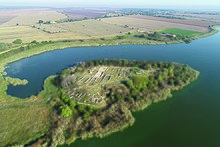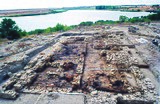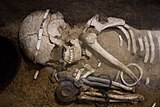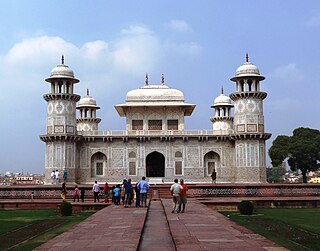
A tomb is a repository for the remains of the dead. It is generally any structurally enclosed interment space or burial chamber, of varying sizes. Placing a corpse into a tomb can be called immurement, although this word mainly means entombing people alive, and is a method of final disposition, as an alternative to cremation or burial.

Empúries was an ancient city on the Mediterranean coast of Catalonia, Spain. The city Ἐμπόριον was founded in 575 BC by Greek colonists from Phocaea. After the invasion of Gaul from Iberia by Hannibal the Carthaginian general in 218 BC, the city was occupied by the Romans. In the Early Middle Ages, the city's exposed coastal position left it open to marauders and it was abandoned.

A tumulus is a mound of earth and stones raised over a grave or graves. Tumuli are also known as barrows, burial mounds or kurgans, and may be found throughout much of the world. A cairn, which is a mound of stones built for various purposes, may also originally have been a tumulus.

Grave goods, in archaeology and anthropology, are items buried along with a body.
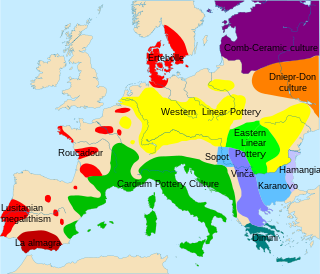
The Hamangia culture is a Late Neolithic archaeological culture of Dobruja between the Danube and the Black Sea and Muntenia in the south. It is named after the site of Baia-Hamangia, discovered in 1952 along Golovița Lake.
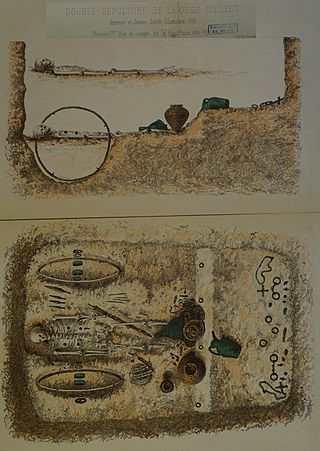
Chariot burials are tombs in which the deceased was buried together with their chariot, usually including their horses and other possessions. An instance of a person being buried with their horse is called horse burial.

Tomb KV43 is the tomb of Pharaoh Thutmose IV in the Valley of the Kings in Luxor, Egypt. It has a dog-leg shape, typical of the layout of early 18th Dynasty tombs. KV43 was rediscovered in 1903 by Howard Carter, excavating on behalf of Theodore M. Davis.

The Varna Necropolis, or Varna Cemetery, is a burial site in the western industrial zone of Varna, internationally considered one of the key archaeological sites in world prehistory. The oldest gold treasure and jewelry in the world, dating from 4,600 BC to 4,200 BC, was discovered at the site. Several prehistoric Bulgarian finds are considered no less old – the golden treasures of Hotnitsa, Durankulak, artifacts from the Kurgan settlement of Yunatsite near Pazardzhik, the golden treasure Sakar, as well as beads and gold jewelry found in the Kurgan settlement of Provadia – Solnitsata. However, Varna gold is most often called the oldest since this treasure is the largest and most diverse.

The National History Museum of Romania is a museum located on the Calea Victoriei in Bucharest, Romania, which contains Romanian historical artifacts from prehistoric times up to modern times.

Pseira is an islet in the Gulf of Mirabello in northeastern Crete with the archaeological remains of Minoan and Mycenean civilisation.

Shabla is a town and seaside resort in northeastern Bulgaria, administrative centre of the Shabla Municipality part of Dobrich Province. Shabla municipality includes the following villages: Bojanovo, Chernomortsi, Durankulak, Ezerets, Gorichane, Gorun, Granichar, Krapets, Prolez, Smin, Staevtsi, Tvarditsa, Tyulenovo, Vaklino and Zahari Stoyanovo. As of December 2009, the town itself had a population of 3,586 inhabitants. It is situated on the Bulgarian Black Sea Coast in the vicinity of the salt-water Lake Shabla and Bulgaria's easternmost point, Cape Shabla.
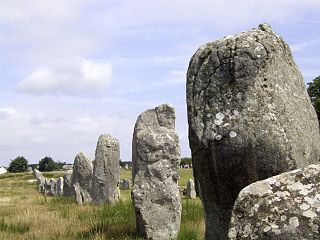
The Carnac stones are an exceptionally dense collection of megalithic sites near the south coast of Brittany in northwestern France, consisting of stone alignments (rows), dolmens, tumuli and single menhirs. More than 3,000 prehistoric standing stones were hewn from local granite and erected by the pre-Celtic people of Brittany and form the largest such collection in the world. Most of the stones are within the Breton municipality of Carnac, but some to the east are within neighboring La Trinité-sur-Mer. The stones were erected at some stage during the Neolithic period, probably around 3300 BC, but some may date to as early as 4500 BC.

The Necropolis of Pantalica is a collection of cemeteries with rock-cut chamber tombs in southeast Sicily, Italy. Dating from the 13th to the 7th centuries BC, there was thought to be over 5,000 tombs, although the most recent estimate suggests a figure of just under 4,000. They extend around the flanks of a large promontory located at the junction of the Anapo river with its tributary, the Calcinara, about 23 km (14 mi) northwest of Syracuse. Together with the city of Syracuse, Pantalica was listed as a UNESCO World Heritage Site in 2005.

The Varna culture was a Chalcolithic culture of northeastern Bulgaria, dated c. 4500 BC, contemporary and closely related with the Gumelnița culture. The oldest golden artifacts in the world were found in the Necropolis of Varna. These artefacts are on display in the Varna Archaeological Museum

Gavrinis is a small island in the Gulf of Morbihan in Brittany, France. It contains the Gavrinis tomb, a Neolithic passage tomb built around 4200–4000 BC, making it one of the world's oldest surviving buildings. Stones inside the passage and chamber are covered in megalithic art. It is likened to other Neolithic passage tombs such as Barnenez in Brittany and Newgrange in Ireland.

The prehistory of Southeastern Europe, defined roughly as the territory of the wider Southeast Europe covers the period from the Upper Paleolithic, beginning with the presence of Homo sapiens in the area some 44,000 years ago, until the appearance of the first written records in Classical Antiquity, in Greece. First Greek language is Linear A and follows Linear B, which is a syllabic script that was used for writing in Mycenaean Greek, the earliest attested form of the Greek language. The script predates the Greek alphabet by several centuries. The oldest Mycenaean writing dates to about 1400 BC. It is descended from the older Linear A, an undeciphered earlier script used for writing the Minoan language, as is the later Cypriot syllabary, which also recorded Greek. Linear B, found mainly in the palace archives at Knossos, Kydonia, Pylos, Thebes and Mycenae, disappeared with the fall of Mycenaean civilization during the Late Bronze Age collapse.

Durankulak is a village in northeastern Bulgaria, part of Shabla Municipality, Dobrich Province. Located in the historical region of Southern Dobruja, Durankulak is the north-easternmost inhabited place in Bulgaria and the northernmost village of the Bulgarian Black Sea Coast, although the village itself is slightly inland. Durankulak lies north of the town of Shabla, with the only places to the north along the coast being the formerly exclusively Czechoslovak camping site Kosmos and the Kartalburun and Sivriburun headlands. Durankulak is also the name of the nearby border checkpoint on the Bulgarian-Romanian border; just north of the border is the Romanian seaside resort Vama Veche.
Mastaba S3504 is a large mastaba tomb located in the Saqqara necropolis in Lower Egypt. It was built during the reign of the ancient Egyptian Pharaoh Djet, in the First Dynasty, shortly after 3000 BC. It is one of the largest mastabas from this dynasty. The building was excavated in 1953 by Walter Bryan Emery.

Etruscan architecture was created between about 900 BC and 27 BC, when the expanding civilization of ancient Rome finally absorbed Etruscan civilization. The Etruscans were considerable builders in stone, wood and other materials of temples, houses, tombs and city walls, as well as bridges and roads. The only structures remaining in quantity in anything like their original condition are tombs and walls, but through archaeology and other sources we have a good deal of information on what once existed.
